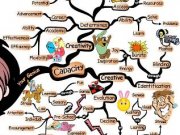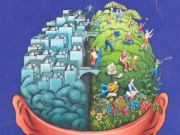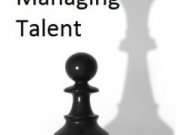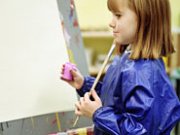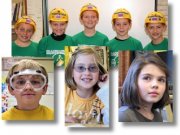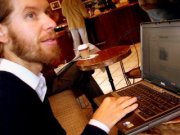
Joyce VanTassel-Baska
Northwestern University
Editor’s Note: From VanTassel-Baska, J. (1986). Effective curriculum and instructional
models for talented students. Gifted Child Quarterly, 30(4), 164–169. © 1986 National
Association for Gifted Children.
This article presents an historical perspective on the evolution of three
curriculum and instructional models that have been shown to be effective
with gifted learners in various contexts and at various grade levels. It
argues for consideration of all three models in a comprehensive program
for gifted learners.
Many people have been attracted to the issue of curriculum for the gifted
because they feel it is new territory. While it is true that curriculum has
not been a central focus in the field until recently, it would be inappropriate
to conclude that we need new models and methods to provide appropriately
differentiated learning experiences for gifted learners. The purpose of this
paper is to present effective curriculum and instructional models that should
form the basis of our curriculum efforts and to discuss their relevance to current
school practices.
Over the last twenty years, general principles about appropriate curriculum
for gifted children have been delineated. Ward (1961) developed a theory of differential
education for the gifted that established specific principles around
which an appropriate curriculum for the gifted would be developed. Meeker
(1969) used the Guilford Structure of Intellect (SOI) to arrive at student profiles
that highlighted areas of strength and weakness so that curriculum planners
could build a gifted program to improve weak areas. Curriculum workbooks
were structured specifically to address this need in the areas of memory, cognition,
convergent thinking, divergent thinking, and evaluation. Renzulli (1977)
focused on a differentiated curriculum model that moved the gifted child from
enrichment exposure activities through training in thinking and research skills
into a project-oriented program that dwelt on real problems to be solved.
Gallagher (1975) stressed content modification in the core subject areas of language
arts, social studies, mathematics and science. Stanley, Keating, and Fox
(1974) concentrated on a content acceleration model to differentiate programs
for the gifted. Recent writings, including Feldhusen and Kolloff (1978), Maker
(1982), and VanTassel-Baska (1984) have stressed a confluent approach to
differentiation of curriculum for the gifted that includes both acceleration
and enrichment strategies. Passow (1982) formulated seven cardinal curriculum
principles that reflect content, process, product, behavioral, and evaluative
considerations.
In examining the state of the art of curriculum and instruction for the gifted,
it is clear that there is a multiplicity of approaches that are adopted wholesale
for classroom use without adequate testing in a research context and without
consideration of their value in the overall educational context. In fact, the recipe
approach seems the most popular at the present time. Throw together a special
unit on the latest topic of interest in the larger socio-cultural context, add creative
problem-solving, mix with higher level thinking skills, and stir in a special research
project until done. In order to implement appropriate curriculum for gifted
students, there must be concern for the faithful translation of sound models for
curriculum and instruction into an action research arena where effectiveness
can be continually tested. The curriculum and instructional models presented
in this paper have all been tested and found effective with gifted learners.
Furthermore, each model emerges from a clearly delineated theoretical and
research context.
The three relatively distinct curriculum models that have proven effective
with gifted populations at various stages of development and in various
2 Curriculum for Gifted and Talented Students
domain-specific areas may be termed: 1) the content mastery model; 2) the
process/product research model; and 3) the epistemological concept model.
THE CONTENT MODEL
The content model tends to emphasize the importance of learning skills and
concepts within a predetermined domain of inquiry. Gifted students are
encouraged to move as rapidly through the content area as possible and thus
content acceleration in some mode tends to dominate the application of this
model in practice. When the diagnostic-prescriptive (D → P) instructional
approach is utilized, students are pre-tested and then given appropriate materials
to master the subject area segments prescribed.
The D → P instructional approach has proved effective in controlled settings,
but has not been widely practiced in regular classrooms for the gifted.
Several reasons appear to account for this: 1) like any individualized model, it
requires a highly competent classroom manager to implement, for if used
appropriately, each student may be working on a different problem, chapter,
and even book at the same time. Regardless of the rhetoric surrounding individualization,
very little of it is actively practiced in basic curriculum areas;
2) most pull-out gifted programs do not focus on core content areas and therefore
avoid the model, even though such teachers are frequently highly skilled in
individualized classroom management, and 3) the approach has not been particularly
valued by many educators of the gifted because of its insistence on
utilizing the same curriculum and merely altering rate. The lecture-discussion
approach to the content model is more widely practiced at the secondary level,
but its effectiveness is highly dependent on teachers being well versed in the
structure as well as the content of their discipline. Too frequently the content
model disintegrates into learning the exact same skills and concepts as all
learners are expected to do in the school context, only doing more exercises and
drill in a shorter period of time.
In the D → P approach, teachers and teaching assistants act as facilitators
of instruction rather than as didactic lecturers; although many content-based
programs for the gifted place a strong emphasis on lecture and discussion. The
curriculum is organized by the intellectual content of the discipline and is
highly sequential and cumulative in nature, making a proficiency-based model for
achievement outcomes very feasible.
The D → P approach to the content model has been utilized effectively by
the talent search programs across the country, particularly in mathematics
(Keating, 1976; Benbow and Stanley, 1983). VanTassel-Baska (1984) has shown
the effectiveness of the model in teaching Latin. And foreign language teachers
have used the model for years to ensure English syntactic mastery in their
students. Clearly it represents the most individualized instructional approach
to basic curriculum for the gifted that might be undertaken, and embodies a
continuous progress philosophy that schools can understand.
Effective Curriculum and Instructional Models for Talented Students 3
4 Curriculum for Gifted and Talented Students
The more typical approach to content-based instruction, however, is one
that presets the mastery level of expectation for students, frequently requiring
more advanced skills and concepts to be mastered one year earlier. The content
model employs existing school curriculum and textbooks, so it is not costly to
implement. And it attempts to respond to the rate needs of individual students,
allowing the very able to move more quickly through the traditional curriculum.
In successful implementations of the model, teachers have made important
alterations in the organization of the subject matter being taught. For example,
in the fast-paced Latin program, the concepts spread out incrementally over
the first three chapters of the book are synthesized into a matrix study sheet,
presenting students all five Latin cases, three genders, and two numbers in their
various combinations all at once. Homework is assigned only from the third unit
where all the interactions of gender, number and case may be practiced. Thus
30 hours of instructional time may be reduced to four or five at the most. And
gifted students have mastered the important concepts governing beginning
Latin syntax in economical fashion.
Thus what appears as a simple process of moving more quickly through
the same basic material takes on a level of sophistication in actual practice.
The effective D →P teacher reorganizes the content area under study according
to higher level skills and concepts so that the focus of student prescriptive
work is in larger increments that carry with them a holistic picture of the topic
under study.
The content mastery model for curriculum and instruction also carries with
it the capacity to reduce the regular skill-based curriculum for gifted learners in
reading as well as mathematics to approximately one-third the time currently
expended. This process occurs through two distinct approaches to modifying
the curriculum: 1) allowing students to move through the skill development
areas at a rate commensurate with their capacity, testing for proficiency and
assigning work based on documented increased levels of development, and
2) reorganizing basic skill areas into higher level skill clusters in order to conserve
mastery learning time and promote more efficient and challenging learning
experiences for talented students.
The first approach might be accomplished through the following modifications:
Reading Curriculum:Topic:Word Attack Skills
Typical Learner Sequence:
Recognizing and → Recognizes and → Phonemes → Prefixes, Suffixes
Sounding out Sounding out Vowels
Consonants
D → P Gifted Learner Sequence:
Pretest on → Analysis of skill gaps → Prescription of work on
Reading inhibiting reading phonemes, prefixes, and suffixes
The second approach would be accomplished through this additional
modification, again in the reading curriculum:
Typical Learner Sequence:
Topic: Word Attack Skills
Subtopics: Recognizing and sounding out consonants, recognizing and
sounding out vowels, phonemes, and prefixes and suffixes.
D → P
Gifted Learner Sequence:
Topic: Reading recognition (whole words)
Subtopics: Word attack skills
Prefixes and suffixes
Root words
Through these two modifications then, gifted students can master the typical
skill-based curriculum in less time and at an appropriate level of complexity and
challenge. For much of the elementary reading, mathematics, and language
curriculum, this approach is feasible and efficacious for gifted learners.
The content mastery model, however, does have some limitations and drawbacks.
It does not work well in learning tasks where speed and compression are
not a relevant consideration. One could hardly imagine reading Shakespeare
based on the tenets of content mastery, nor probing a significant world problem.
In addition many teachers have interpreted the content mastery model to be
merely “covering material” faster and assigning greater amounts of homework,
so that many special classes using it deteriorate into a focus on the quantity of
consumed material rather than the quality of the learning experience.
THE PROCESS-PRODUCT MODEL
The process/product model places heavy emphasis on learning investigatory
skills, both scientific and social that allow students to develop a high quality product.
It is a highly collaborative model that involves teacher-practitioner-student as an
interactive team in exploring specific topics. Consultation and independent work
dominate the instructional pattern, culminating in student understanding of
the scientific process as it is reflected in selective exploration of key topics.
Discussed in the literature under the rubric of programs like enrichment
triad and the Purdue model (Renzulli, 1977; Feldhusen and Kolloff, 1978),
this approach to curriculum for the gifted can be viewed as successful. At the
secondary level, special science programs for the gifted have used the model
(VanTassel-Baska and Kulieke, 1986). And institutions like Walnut Hills
Effective Curriculum and Instructional Models for Talented Students 5
High School in Cincinnati, Bronx High School of Science, and the North
Carolina School of Math and Science have practiced the model as a part of their
high-powered science programs for a number of years.
The model seeks to engage the student in problem-finding and problemsolving
and to put him in contact with adult practitioners. In the field of science,
for example, scientists from Argonne National Laboratory work with academically
talented junior high students during the summer to help them develop
research proposals for project work during the following academic year. Students
actively engage in the generation of a research topic, conduct a literature search,
select an experimental design, and lay out their plan of work in a proposal. The
proposal is then critiqued by their instructor and the scientist. In this way then,
students focus on process skill development in scientific inquiry and strive to
develop a high quality product. The following chart delineates the three stages
of the inquiry process used in the Northwestern-Argonne program.
Pre-Inquiry (Level 1 skills)
____ 1. The student has acquired scientific knowledge relevant to the question
being asked.
____ 2. The student has done a review of related background literature.
Methods of Inquiry (Level 2 skills)
____ 1. The student plans to:
____ a. use the techniques of identifying objects and object properties.
____ b. use the technique of making controlled observations.
____ c. examine changes in various physical systems.
____ d. order a series of observations.
____ e. classify various physical and biological systems by coding and
tabulating data.
____ f. use the techniques of ordering, counting, adding, multiplying,
dividing, finding averages, and using decimals.
____ g. demonstrate the rules of measurement as applicable to specific
physical and biological systems (i.e., length, area, volume,
weight, temperature, force, or speed).
____ h. conduct an experiment by identifying and controlling variables.
____ 2. The student has created operational definitions for the variables under
study.
____ 3. The student has stated a testable research hypothesis.
6 Curriculum for Gifted and Talented Students
____ 4. The student plans to manipulate some type of materials.
____ 5. The student has followed the specified proposal format.
Interpretive Inquiry Skills (Level 3 skills)
____ 1. The student transformed the observed results into graphs, tables,
diagrams, and reports.
____ 2. The student drew relationships among things he or she had observed.
____ 3. The student generalized from his observations.
____ 4. The student interpreted tabular and graphical data.
____ 5. The student used the skills of interpolation and extrapolation to make
predictions based on his data.
____ 6. The student made inferences based on his data.
____ 7. The student related data to statements of hypotheses.
____ 8. The student related previous work to his/her own.
____ 9. The student used the specified project format.
____ 10. The student developed some limitations of his study.
The process-product model for curriculum and instruction of the gifted differs
from the content mastery model in that content is viewed as less important and
rarely acts as the organizer for this type of curriculum. Student interest is a
mainspring for what “curriculum” will be studied. The nature of the evaluation
effort is product-based rather than proficiency-oriented, and the focus is on
studying selected topics in-depth rather than moving through a given domain
of inquiry in a fast-paced manner.
While the model has worked well in some pull-out programs for the gifted
and as a part of a total science program at the secondary level, it does present
organizational problems for many schools: critics contend that the focus of this
model creates confusion around the curricular scope and sequence of learning
at any given level of instruction and creates a need for articulating new process
and product dimensions into an adopted scope and sequence continuum for the
gifted. Furthermore, the model at the elementary level tends to devalue core
content elements in the traditional curriculum, and to overvalue independent
learning strategies at that stage of development.
Effective Curriculum and Instructional Models for Talented Students 7
Nevertheless, it is the curriculum and instructional model most closely
allied with the recommendations of national teacher groups in both science and
mathematics that tend to favor a student-directed, hands-on, inquiry-based
process of problem-solving, where students are engaged in the act of constructing
knowledge for themselves.
THE EPISTEMOLOGICAL MODEL
The epistemological concept model focuses on talented students’ understanding
and appreciation of systems of knowledge rather than the individual segments
of those systems. It reflects a concern for exposing students to key ideas,
themes, and principles within and across domains of knowledge so that
schemata are internalized for amplification by new examples in the future. The
role of the teacher in this model is as questioner, raising interpretive issues for
discussion and debate. Students focus their energies on reading, reflecting, and
writing. Aesthetic appreciation of powerful ideas in various representational
forms is viewed as an important outcome of this model.
The model is very effective with gifted learners for several reasons. First of
all, the intellectually gifted child has unusually keen powers to see and understand
interrelationships; therefore, conceptual curriculum is useful, for its
whole structure is based on constantly interrelating form and content. Concept
curriculum is an enrichment tool in the highest sense, for it provides the gifted
with an intellectual framework not available in studying only one content
area, but rather exposes them to many not covered in traditional curricula.
Furthermore, it provides a basis for students’ understanding the creative as
well as the intellectual process through critically analyzing creative products,
and being actively engaged in the creative process itself. And lastly, it provides
a context for integrating cognitive and affective objectives into the curriculum.
A discussion of ideas evokes feelings; response to the arts involves aesthetic
appreciation, and study of literary archetypes creates a structure for self identity.
Many writers in the field of gifted education have advocated the epistemological
approach to curriculum for the gifted (Ward, 1961; Hayes-Jacob, 1981;
Maker, 1982; Tannenbaum, 1983). And some extant curriculum has been organized
around the model at both elementary and secondary levels. The College
Board Advanced Placement Program in history (both American and European)
as well as their literature and composition programs rely heavily on this curriculum
and instructional model.
The Junior Great Books program, Philosophy for Children, and Man: A
Course of Study (MACOS) are elementary programs using the approach. Each
of these programs stresses the use of Socratic questions to stimulate an intellectual
discussion among students on an issue or theme. Creating analogies across
a field of inquiry is encouraged, and interdisciplinary thinking is highly valued.
Recent curriculum development efforts for the gifted have attempted to utilize
the epistemological framework (VanTassel-Baska and Feldhusen, 1981; Gallagher,
8 Curriculum for Gifted and Talented Students
1982). And larger curriculum projects in the past, such as CEMREL’s mathematics
program at the secondary level and the Unified Mathematics program at the
middle school level, have utilized a holistic approach to the organization of content.
At the Secondary level, humanities programs have often been the reservoir
for the use of this model with talented learners. One approach to framing discussions
with the humanities is to structure questions about a work of art
(whether it be music, painting, or literature) that asks students to examine an
“art” object from a variety of perspectives. For example, the following questions
might be posed about a poem:
1) What is it? (What’s the subject matter?)
2) What is it made of? (What is its form?)
3) What ideas does it convey? (What does it mean?)
4) What is its context? (How would you categorize it historically?)
5) How do you relate to it? (What is its personal value?)
6) How good is it? (What is your evaluation of its artistic merit?)
Through these several lenses, then, gifted learners can explore the humanities
as a collection of creative products assembled by individuals over the centuries,
and reflect on their relationship to each other in specified dimensions. Thus
appreciation for the arts can be developed through “seeing” them from various
points of view.
While the concept-based model of curriculum offers the advantages of a
unified view of a field of inquiry often undertaken by scholars in individual
disciplines, it requires well-trained teachers to implement it effectively.
Teachers need to possess not only in-depth knowledge about one field of
inquiry but also must have the capacity to make appropriate connections to
other disciplines as well. And there is a need to keep in place a consistent vision
around the exploration of concepts. Furthermore, schools have never really
known how to treat such curriculum organizationally. At the secondary level,
should students receive an English credit for a humanities course or a social
studies credit? Should humanities be offered only at senior level as an elective
or earlier as a mandatory course? The very strength of this curriculum and
instructional model as an integrating force frequently breaks down in the organizational
decision-making over “where it fits.” As with the other two models
discussed, developing a scope and sequence within the epistemological orientation
would seem to be necessary to allow for appropriate student exposure
and progressive development in the realm of ideas.
The concept model for curriculum and instruction differs considerably from
the nature of the previous two models (see Figure 1). It is organized by ideas
and themes, not subject matter or process skills. It is a highly interactive model
in its instructional context, which contrasts with the more independent modes
Effective Curriculum and Instructional Models for Talented Students 9
of instruction used in the other two models. Concern for the nature and structure
of knowledge itself is a major underlying tenet. And evaluation of students
engaged in this model typically requires evidence of high level aesthetic perceptions
and insights rather than content proficiency or a culminating product
of high quality.
Implementation of Curriculum and Instructional Models
The explication of these three models may be useful in advancing our
understanding of how the confluent approaches to curriculum that are currently
advocated might be implemented in the context of school-based programs.
Clearly, it is not advantageous to select one model over another when planning
appropriate curriculum over a span of years, for each approach responds to
different characteristics and needs of gifted learners. Acceleration and in-depth
as well as broad-based enrichment opportunities are all valuable for the gifted.
There is a need, however, to consider the nature of separate curriculum
areas which may lend themselves more readily to one model than another. And
within a population of gifted learners, there may be important differences to
consider in relationship to curriculum models. There is a motivational factor
that must be considered for certain types of curriculum approaches that involve
independent investigations or studying a content area at a fast rate. Learning
preferences among talented learners should also be considered. Some gifted
students prefer to learn rapidly and go on to more sophisticated work at a
higher level; others prefer to examine a problem from all sides and deliberate
over it in depth. As Renzulli (1978) has demonstrated, task commitment is a
necessary student variable to perform well in the process-product curriculum
model. And the concept model may work best with students evidencing high
level verbal capacity and broad-based reading behaviors. Figure 2 presents a
matrix that matches model type with content organizational issues and salient
student characteristics.
The real issue is how best to conceptualize and operationalize the functional
utility of these models at different stages of development and in different
program organizational models. Figure 3 presents a confluent model of the
three curriculum and instructional approaches as they might be viewed within
10 Curriculum for Gifted and Talented Students
Figure 1 Contrasting Curriculum/Instructional Models for the Gifted
A (content) B (process/product) C (concept)
fast-paced in-depth on selected topics epistemological
proficiency-based product based aesthetics-based
D→P approach resource-oriented discussion approach
organized by organized around organized by themes and ideas
intellectual content scientific process
teacher as facilitator collaborative model Socratic method
an academic year program at the local school district level. Each model is allotted
equal amounts of instructional time and equal focus in a student’s program.
While a full-time grouping model would be the most feasible to operationalize
this confluent model, it could be considered under other grouping
patterns as well, notably resource room and pull-out where regular classroom
teachers or other specialists would facilitate models A and B. Model C work
then would be reserved for gifted program time.
As with the adaptation of any curriculum model, partial or selective implementation
may also be appropriate for individual students at a given stage of
development. Students may elect to participate in a special humanities seminar
but not elect to engage in accelerated study, for example. However, adaptations
in the integrative pattern should be viewed as student-selected alternatives
rather than limitations in the school-based program options.
Effective Curriculum and Instructional Models for Talented Students 11
Figure 2
Model Type Preferred Content Match Salient Student Characteristics
A Content Mathematics (traditional) Independent learner
Foreign Language High achievement
English Grammar motivation
Reading
B Process/ Product Science High interest in single topic
Mathematics (problem-solving Task commitment
orientation)
Writing
C Concept Humanities High level verbal reasoning skills
Social studies (e.g. history, Broad-based interests and
economics) reading behavior
Literature
Figure 3 School-Based Curriculum Model Linkages on an Academic Year Cycle
Modifications of
Core Curriculum Extended Core Curriculum Curriculum Integration
D→P Content Approach Process/Product Epistemological Concept
Research Approach Approach
A B C
Allows for speeded, Allows for development of Allows for idea
compressed, economized generic problem discussion/generation within
version of regular finding/problem solving and across disciplines
curriculum skills in selected
curriculum contexts
Effective curriculum and instruction for the gifted has reached a stage of
evolution where existing theoretical and research-based models need to be
systematically translated into practice at the local level. Competition among
these models has dissipated the effect of building a strong differentiated program
for the gifted that addresses all of their intellectual needs within the core curriculum
and beyond it to all levels of instruction. The synthesis of the content,
process-product, and concept models provides a clear direction for meaningful
curriculum work.
REFERENCES
Benbow, C., and Stanley, J. (1983). Academic precocity: Aspects of its development.
Baltimore, MD: Johns Hopkins University Press.
Feldhusen, J., and Kolloff, M. (1978). A three stage model for gifted education. G/C/T, 1,
53–58.
Gallagher, J. (1975). Teaching the gifted child (2nd Ed.). Boston: Allyn & Bacon.
Gallagher, J. (1982). Leadership. New York: Trillium Press.
Hayes-Jacob, H. (1981). A model for curriculum and instruction: Discipline fields, interdisciplinarity,
and cognitive processes. Unpublished doctoral dissertation, Columbia
University, New York.
Keating, D. (1976). Intellectual talent. Baltimore: The Johns Hopkins Press.
Maker, C. J. (1982). Curriculum development for the gifted. Rockville, MD: Aspen Systems
Publication.
Meeker, M. (1969). The structure of intellect: Its interpretation and uses. Columbus, OH:
Charles E. Merrill Publishing Co.
Passow, H. (1982). Differentiated curricula for the gifted/talented in Kaplan, Sady et al.,
Curricula for the Gifted, Committee Report to the National/State Leadership
Training Institute on the Gifted and the Talented, Ventura County, California: Office
of the Superintendent of Schools.
Renzulli, J. (1977). The enrichment triad. Wethersfield, CT: Creative Learning Press.
Renzulli, J. (1978). What makes giftedness? Re-examining a definition. Phi Delta Kappan,
60, 180–184, 261.
Stanley, J., Keating, D., and Fox, L. (1974). Mathematical talent. Baltimore: The Johns
Hopkins Press.
Tannenbaum, A. (1983). Gifted children. New York: Macmillan.
VanTassel-Baska, J. (1984). Appropriate curriculum for the gifted. In J. Feldhusen (Ed.),
Toward excellence in gifted education (pp. 45–83). Denver: Love Publishing Co.
VanTassel-Baska, J., and Feldhusen, J. (Eds.). (1981). Concept curriculum for the gifted K-8.
Matteson, IL: Matteson School District #162.
VanTassel-Baska, J., and Kulieke, M. (in press). The role of community-based resources in
developing scientific talents: A case study, Gifted Child Quarterly.
Ward, V. (1961). Educating the gifted: An axiomatic approach. Columbus, OH: Charles
Merrill Company.




